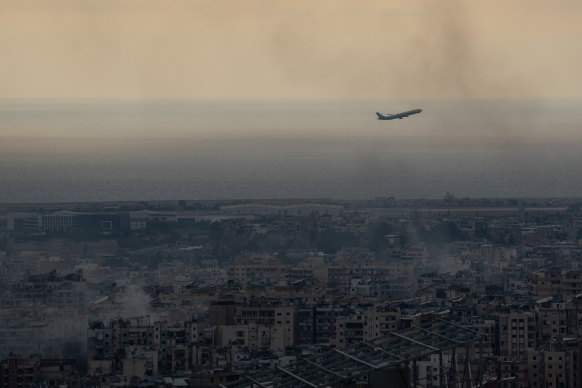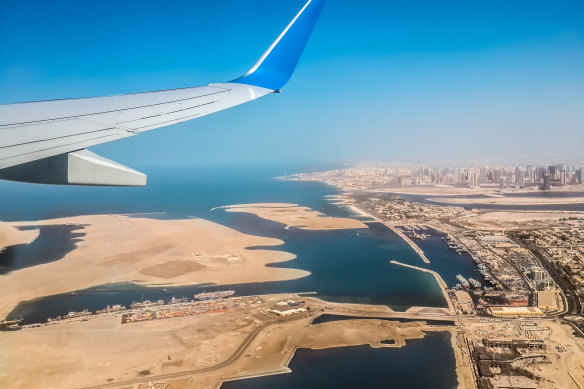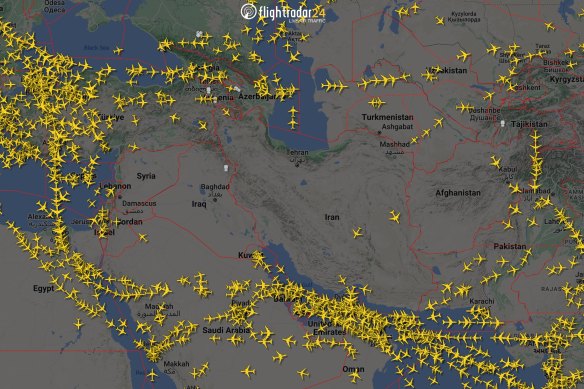Opinion
Middle East conflict has caused chaos for flights to Europe
Michael Gebicki
The TripologistThe recent outbreak of hostilities between Iran and Israel has sent flights between Europe and Australia into a tailspin.
Belinda Jackson, one of Traveller’s regular contributors, experienced the chaos first-hand when she left Bulgaria on October 3, en route to Australia via Qatar.
“What should have been a neat little 21-hour trip from Sofia-Doha-KL-Melbourne with Qatar Airways turned into a three-day event broken by catnaps, with overnights in Doha (14 hours) and a surprise stay in Singapore (23 hours),” said Jackson.

A plane departing Beirut flies near smoke from Israeli air strikes on October 6, 2024.Credit: Getty Images
During her unexpected layover in Doha, when her flight from Bulgaria failed to arrive in time to meet the 60-minute transfer time for her onward flight, she encountered many travellers with similar stories, including a Belgian couple who’d been there for 40 hours, waiting to fly on to Bangkok.
After leaving her hotel in Bulgaria at 6am on October 3, Jackson arrived at her Melbourne home at noon on Sunday, October 6.
The air traffic problems began on October 1, when Iran rained missiles on military and security targets in Israel. In anticipation of an Israeli retaliation, Jordan, Iraq and Lebanon immediately announced the closure of their airspace while Iran’s airspace became a no-go area for many airlines.
Caught up in the mess, Air France flight AFR218, which left Paris on October 1, before the flare-up, bound for Mumbai, turned back shortly after it crossed from Turkey into Iraq when that country closed its airspace, forcing the aircraft to return to Paris. Subsequent AFR218 flights have followed a more southerly route, over Egypt, Saudi Arabia and the Persian Gulf.

Since Middle Eastern hubs are often used by Australian travellers, we have been among the most affected.Credit: iStock
Other airlines were similarly affected. Flights to Dubai, Doha and Abu Dhabi originating from European cities have been forced to fly longer routes. Some have been diverted to other cities, including an Emirates flight from Rome to Dubai flight that ended up in Athens. Passengers have been arriving at the Middle East hubs hours behind schedule, causing many to miss their connecting flights. Since these hubs are often used by Australian travellers, we have been among the most affected.
Connecting times between flights are often tight at the Middle Eastern hubs. This suits most travellers since it means a shorter flight time, but it also becomes a vulnerability when incoming flights arrive late. A longer connecting time, or even a stopover, makes it possible for travellers to absorb such events without affecting their travel plans.

An image from Flight Radar 24 shows aircraft avoiding the airspace over Iran in the wake of missile attacks.Credit: FlightRadar24.com
What’s the outlook?
The situation appears to be easing. Most of the aircraft travelling between Europe and the Middle East hubs have been re-routed to fly via Egypt and Saudi Arabia. Western Iran, normally a busy air corridor, is currently seeing far fewer flights according to Flightradar24, with much of the slack taken up by eastern Iraq.
Does this mean cheap flights via the Middle East?
While you might expect that the current uncertainty might cause a sudden drop in flight bookings to Europe via the Middle East, and a consequent fall in ticket prices, that’s not happening. On Skyscanner, return fares from Australia to Europe for the month of October show no sign of a dip. Looking further ahead into November there’s a price fall, but this is seasonal and expected, followed by rising prices in December, peaking toward the end of the month.
One surprising development from the escalating tensions has been an increase in the number of flights over Afghanistan. In seeking to avoid Iranian airspace, more airlines are instead routing flights over Afghanistan, Singapore Airlines and British Airways among them. Afghanistan has been without air traffic control since departing US forces destroyed the country’s ATC systems when they withdrew in 2021.
Am I entitled to compensation for flight delays caused by war?
While airlines will make every effort to get passengers to their destination in the current circumstances, it’s likely that requests for compensation would fall on deaf ears. Since the delays are caused by events beyond their control, airlines will probably invoke force majeure clauses, which absolves them from paying compensation, for example for flights that arrive late in the EU. Travel insurance policies have similar clauses in their product disclosure statements. However, as in Jackson’s case, most airlines have been proactive, arranging hotel rooms for delayed flyers and providing meal vouchers.
How dangerous is it to fly via the Middle East right now?
Most flights to cities in Jordan, Lebanon, Israel and Iran have been cancelled and governments in Australia, the UK and USA have upgraded their travel advisories for these countries. Travellers flying via the major Middle East hubs are not considered under threat. Terrifying as they are, missiles are aimed at ground targets, they do not present a threat to civilian aircraft flying at cruise altitude. However travellers should be prepared for unexpected delays, with a change of clothing, toiletries and any essential medications in their carry-on luggage.
Sign up for the Traveller newsletter
The latest travel news, tips and inspiration delivered to your inbox. Sign up now.